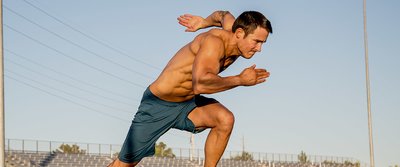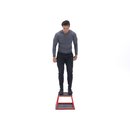Most runners believe that in order to be better-performing and faster-running machines, they simply need to run more and hone their craft by following a well-designed running program. Well, that's only half true.
The other piece of the puzzle comes from a structured resistance-training program. Even if a runner wishes to improve her running time at the middle or long distances, training for strength in the gym is no longer merely an option—it's a must.
No butts or coconuts about it: If you want to see marked improvements in your race times, you need to run to the gym. (And then lift in it, of course.)
The Benefits Of Strength Training For Runners
In reference to endurance runners, a 2014 systematic review from The Journal of Sports Medicine states that a "general maximal-strength oriented program may initially be the most appropriate and efficient method for improving maximal force, power and reactive-strength capabilities."[1]
In normal people language, that means a simple, no-frills strength-training program for endurance runners with presumably little-to-no lifting experience—meaning you are unfamiliar with exercise technique or the capabilities of your current physical and neuromuscular strength—will help you develop significant improvements in long-term performance.
Keeping up so far? Good! Hang onto your laces, because the following flow chart showing the benefits of strength training for running is a real doozy!

(Beattie et al., 2014)
It's OK if you're lost. Trying to follow all the arrows in the picture would make most people run for the hills! For those who stuck around, this model essentially suggests that strength training plays an important role in improving all of the vital contributors to a faster run speed: anaerobic power, neuromuscular efficiency, running economy, and power development capabilities.
Strength training provides a far greater benefit than simply making your overall body more robust. Better anaerobic power and capacity means you can maintain a higher intensity for longer periods of time without feeling like your lungs went through a pasta maker. Improved neuromuscular efficiency simply helps you more quickly recruit the necessary muscle fibers to perform, and a more efficient running economy means you'll expend less energy to run a given distance. When you need that extra boost in power in the final sprint of a race, you'll have the power generation capabilities to do that, too.
All of these qualities translate to faster, longer distances with the same energy output over time.
5 Strength-Building Rules for the Runner
Despite the aforementioned benefits, many runners still eschew weight training to avoid building too much mass or getting injured. Fair enough, but as I mentioned, a simple strength-training program for runners makes either of those issues highly unlikely.
This is mainly because the high ratio of time spent endurance running to time spent weight lifting makes it really, really difficult for you to build any considerable mass. The physiological adaptations from running actually interfere with the physiological changes associated with weight lifting, making building muscle about as difficult as digging a hole with a spoon. Still, that's not the goal, anyway.

Better anaerobic power and capacity means you can maintain a higher intensity for longer periods of time without feeling like your lungs went through a pasta maker.
The goal here is to get you a stronger running body. You won't look like Arnold, trust me. So, here we go:
1. Lift year-round, but back off during racing season
Build your aerobic base during the fall season and focus on building maximal strength at other times of the year. It's more important that you focus on building a solid foundation of strength and movement proficiency with the major lifts (more on that in the next point) than anything else. Simply dial back the strength-training frequency during racing season to ensure you don't cut into the recovery and performance of your running training.
Just as you would continue to run to keep from getting rusty, you would keep lifting weights to ensure that the body stays strong throughout the year. Alas, a break of just a couple of weeks from heavy stimuli can be enough to signal your body to start shedding strength.
2. Choose functionally superior exercises
Not all exercises are created equal. The strength and neuromuscular improvements from exercises like squat and deadlift variations will definitely offer far more carryover to running than isolation curls. I recommend checking the Bodybuilding.com Exercise Database or having a certified strength and conditioning coach instruct you on proper and safe lifting techniques for these exercises.
Single-leg variations, like single-leg split squats, single-leg deadlifts, and lunge variations are also important for the development of dynamic stability, which is important for increasing running economy.

The strength and neuromuscular improvements from exercises like squat and deadlift variations will definitely offer far more carryover to running than isolation curls.
3. Train within a spectrum of sets and repetitions
Exercise repetitions (aka reps) refer to the number of times you perform the same exercise one after another, and sets refer to how many total times you perform those repetitions in distinct groups, as in "3 sets of 10 reps." There are ideal rep and set ranges for different effects on muscle, but for our purposes, focus on lifting weights that challenge you in the 5-reps-or-less range.
That means you should choose a weight that makes you feel like your muscles are on fire by the fifth rep. This 5-rep range works best for squats and deadlifts. For single-leg variations, focus on the 8-12-rep range.
For core stabilization exercises, focus on timed sets lasting 30-60 seconds.
4. Lift weights with a ballistic intent
In other words, you need to move the weight as quickly as possible with your best form and technique possible, regardless of weight. Sometimes the weight will move slowly, but your "ballistic intent" will preferentially recruit your fast-twitch muscle fibers. Doing this will help with power generation for times when you need to really push off in the last mile.
5. Jump, hop, and skip
Frog jumps, jump squats, bounding, quick high-knees—these are all forms of explosive bodyweight training called plyometric training. Plyometrics can improve the stretch-shortening cycle of your lower limbs by making joints, tendons, and muscle less stiff. (Don't worry, stiffness isn't a bad thing.)
When your foot lands with each running stride, your tendons and muscles store elastic energy, which can be utilized for the subsequent push off the ground. The better you utilize this energy, the better your running economy becomes.

Jump squats
Sample Runner's Workout
This sample workout can be performed once a week, preferably not on the same day as a running workout. Focus on proper exercise form to ensure exercise effectiveness and gym safety. As a side note, a movement screen and analysis of your running gait are also recommended to ensure that your joints are moving properly when lifting and running.

BodyFit
$6.99/month- 2,500+ expert-created single workouts
- 3,500+ how-to exercise videos
- Detailed workout instruction
- Step-by-step workout tips
- Training at gym or at home
- Access to Workout Plans
- Access to Bodyfit App
- Store Discounts
Already have a Bodybuilding.com account with BodyFit? Sign In

What comes with BodyFit?

- Instructional Videos
Don't risk doing a workout improperly! Avoid injury and keep your form in check with in-depth instructional videos.

- How-to Images
View our enormous library of workout photos and see exactly how each exercise should be done before you give it a shot.

- Step-by-Step Instructions
Quickly read through our step-by-step directions to ensure you're doing each workout correctly the first time, every time.
References
- Beattie, K., Kenny, I. C., Lyons, M., & Carson, B. P. (2014). The effect of strength training on performance in endurance athletes. Sports Medicine, 44(6), 845-865.




